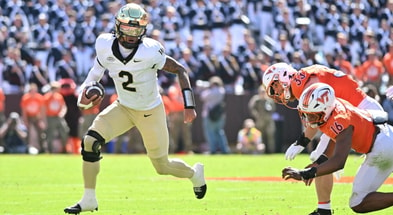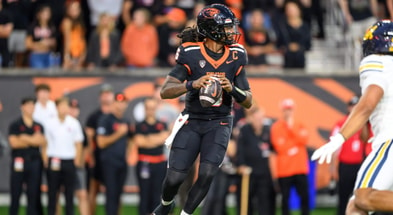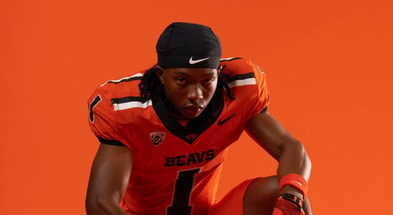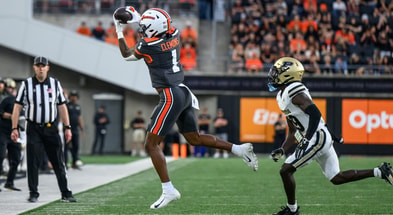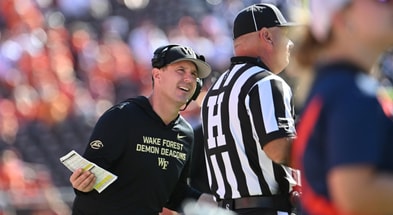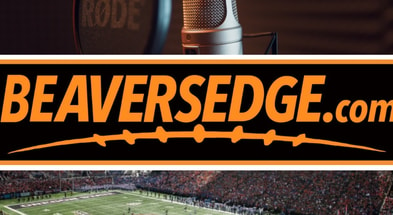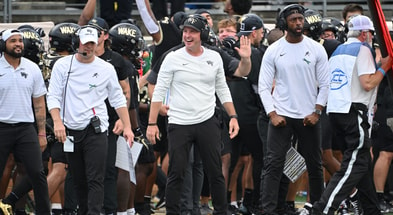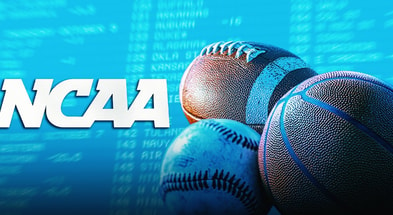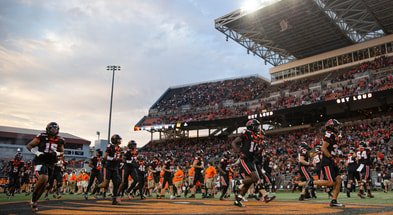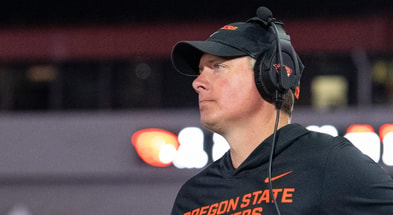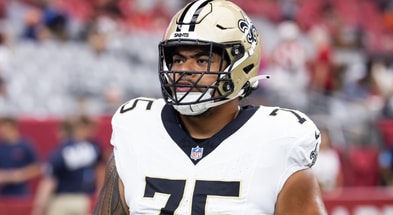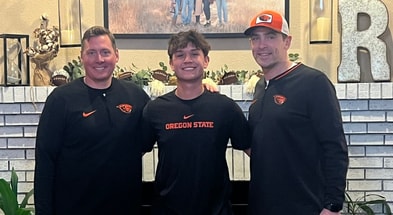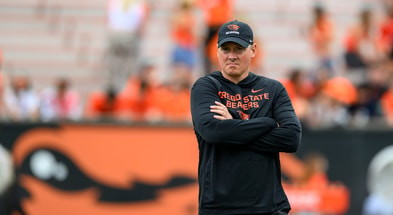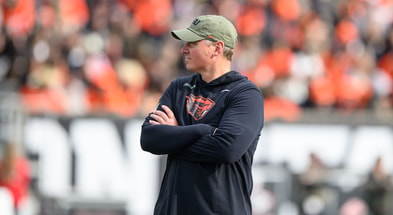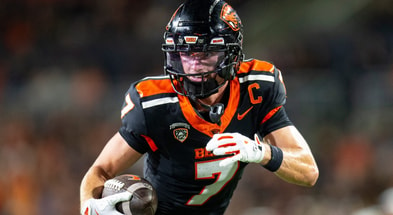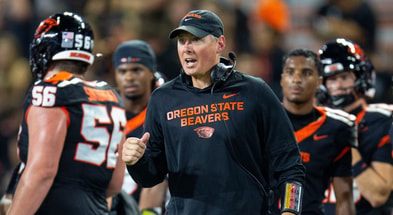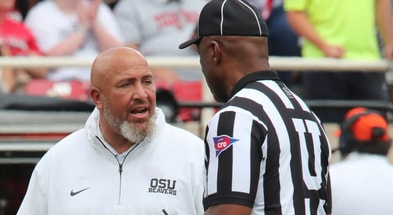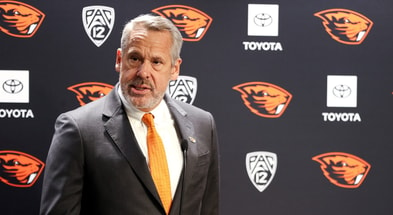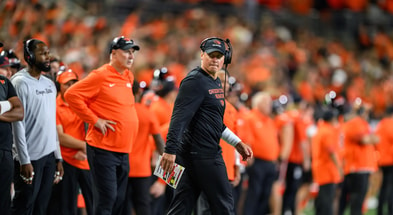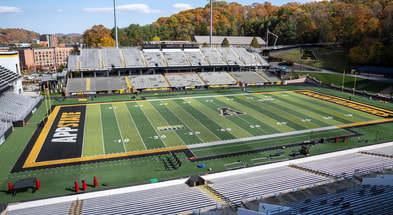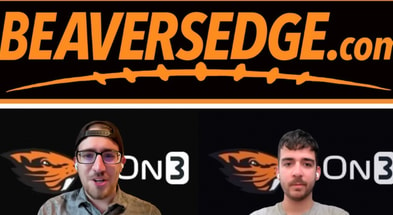Q&A With Oregon State Executive Deputy AD Brent Blaylock
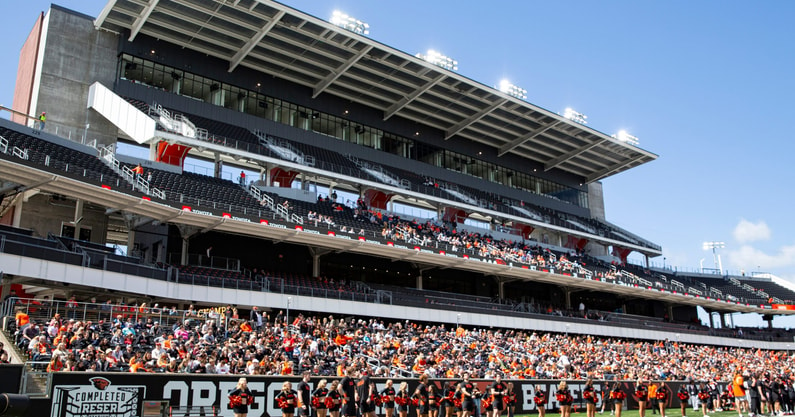
BeaversEdge Senior Writer Ryan Harlan caught up with Oregon State Executive Deputy Athletic Director Brent Blaylock to talk NIL, Blueprint, and much more!
Note – Questions and responses have been edited for clarity –
First things first, could you walk me through, kind of step by step, the breakdown of the contract itself?
Brent Baylock: “So the agreement is broken down. There’s essentially three different tiers. The first tier is the guarantee that goes directly to the student-athletes. That’s the first $750,000. So 100% of those of the first $750,000 that is earned in this goes directly to the student athletes. From there, the revenue sharing portion starts from $750,001 up to $1.15 million. That is where Blueprint will take 75% of that amount. Again, that’s being done to help them recoup the costs that they need to help drive other revenue streams. And then once the net revenue clears $1.15 million, then it is a 50-50 split from there. That’s being done so that there’s a lot of motivation on all sides to grow the pie to be as big as we can get it.”
So, from that $750,000, how does that go back to them? Because from the way that I kind of understand it, that number also increases by 3% each year as well. How does, at least from what you’re saying about that number going back into student athletes’ pockets, how does that go back in there in terms of the mechanism of the contract itself?
BB: “Well, there’s really a limitless amount of ways that Dam Nation can help support our student athletes with those funds. I mean, that can be done through event appearances, that can be done through promotional activities, that can be done, you know, maybe they do some signings, and that can be done through, you know, some merchandise. So there’s really about any way that you can think of to create revenue. Dam Nation can then do that with the student athletes. So they may sign a student athlete on so that they help promote Dam Nation online in general, or help promote an event or maybe Dam Nation gives them a separate appearance fee to come to an event or whatever it may be. It all comes from those different ways. Okay. And that’s really why we’ve partnered with them, because they’re the experts in that space.”
Why Blueprint for Oregon State? The partnership there, my follow-up to that was, were there any other options that you guys looked at outside of Blueprint? Or was Blueprint and what they could offer really kind of the selling point for this partnership?
BB: “Yeah. So, you know, the value that Blueprint provides is that they’ve been in the space from the beginning. They’ve been on partnerships, you know, with 60-plus different campuses across the country. They’ve been at extremely high resource. They’ve been at, you know, some places that are resource-challenged.
So they’ve seen how to make this work across that spectrum and know what those best practices are. How we got to this with Blueprint, there was some due diligence that was done within the athletic department. Not only myself, but a handful of colleagues as well, just reaching out into the marketplace, talking to other partners that they had had.
But there was also due diligence done in the transition of ownership because the thing to remember this as well is that Blueprint is our partner because the previous ownership group of Dam Nation sold Dam Nation to Blueprint.
And I first just want to make sure that I’m very complimentary, very appreciative of all that Kyle Bjornstad did to build up Dam Nation and all he did for our student athletes during that time. You know, he was really remarkable in that space. When he then decided to evaluate the options of transitioning ownership for that, I believe he talked to multiple entities on that.
That was my impression at the time, that he had at least a couple he was reviewing. So I can assume that there was some due diligence on that as well, just to make sure whoever he was selling what he’d worked so hard to put forward, that they were going to take that on in the right way.”
But do you know of any of those partners by any chance that were talked to in those discussions?
BB: “I don’t have all of that right offhand. I know for sure there was, as far as the entire list, I know for sure there were reachouts to individuals at the University of Maryland, NC State University. Those are some of the initial ones that came to mind. But I know there were others as well. I just don’t have all that.”
From what was reported in that Sportico article, it seems to be the point of contention with a lot of Oregon State fans. Trying to understand exactly how the split would be with that $3 million of net direct revenue a year, with the article saying that it would be about $1.5 million or slightly more than half. How did that split come around? Because, from my understanding, from looking at other agreements, looking at Nevada was around 20%, and then Vanderbilt was around 35% or so there. So I’m just kind of wondering how that split came around?
BB: “So the first thing to remember is with all these different revenue streams, Blueprint is taking a different percentage of all of those.
And it was very important for us to protect the revenue streams that are impacted directly by those that are most important to us, which is our student athletes and our supporters. And that’s why when it comes to the membership revenue, so when someone goes on to their website, clicks, signs up for a website or for a membership, if they sign up for a $500 a year membership, all $500 of those dollars will go directly to a student athlete. So we’re protecting our supporters in that way.
Also, when it comes to our student athletes, if Blueprint goes out and signs them to an individual NIL deal. So let’s just say they go to a company, and the company agrees to pay student athlete $100,000 to work with them. Blueprint will go to a student athlete and say, hey, we got you a $100,000 deal.
The student athlete will get all $100,000 of that deal. And the reason why is we’ve been told their rate percentage to help negotiate that on behalf of the student athletes is only going to be about 10%. And then what they do is they go to that company and they say, hey, it is $110,000 for you to do that deal so that we can make sure that the student athlete is made whole with that entire $100,000.
So that 10% rate is actually very favorable and competitive with how a lot of those other rates we’re seeing across the country, both with some of these larger organizations and also just some of these individual agents that are working on their own. When looking at us as compared to different places, both campuses now and maybe previous deals and what it may be, it’s always about time and place.
And it’s where you are right now in the market, where you are as an institution, where you are with the local community and the things that are available there to your student athletes and some of those things.
So there will always be some variance from school to school. What we are seeing is that this deal is in line with a lot of the other deals that not only Blueprint has signed, but some of those others. None of them are always going to be identical, but how the money kind of works out in the end, it gets to a good place.
And the three things that were important to us was to ensure that we got that upfront guaranteed money, that $750,000 that we know for sure every year we’ll be going to student-athletes, so our coaches can bank on that so that they can recruit and retain the type of student-athletes we need to be successful. The second part was that straight-line membership revenue that’ll go directly to the student-athletes so that our fans know when they choose to support through a membership, that that money is not being spent elsewhere. That is going directly to the student athletes.
And then third, that our student-athletes, when Blueprint is going out to negotiate an individual NIL deal on their behalf, they know that they are being paid a very competitive rate. So that all comes together with that. I think the last thing just to note with this when we talk about percentages, and I understand why the $3 million number was used, because the rate certainly does get higher as you get up to that $3 million.
But this in a lot of ways is new money or found money, however you want to call it, because now after house, a lot of what used to be going on through collectives, where people would call up, donate, that money would then be passed through to the student-athlete. Well, a lot of that money is now being given directly to the institution and being provided to the student-athlete through institutional rev share. So that traditional model of what was going on before has now changed.
And what we’re seeing now is this true NIL as was defined and how it needed to be with a valid business purpose and with a range of compensation. And so with that, that is different from what a lot of collectives have looked like in the past. I mean, we’re now three, four months into that new reality of what that’s going to be.
And that’s not necessarily dollars or revenue streams that were significantly present before. So as new money is brought in with this, in a lot of ways it’s found money that couldn’t have or wouldn’t have been counted on in previous years.”
From the way that I am reading through those first four pages, that membership fees fall under this kind of net-generated revenue, the revenue language in here, this kind of baseline revenue that you are generating for the deal. So any kind of existing revenue streams that come into this deal. How is that mechanism, I guess, being protected to give money to those Oregon State student athletes?
BB: “Yeah. So it’s a very good question. So yes, the membership revenue is part of that net direct revenue.
But within that bucket, and as those various percentages are hit, within a blueprint, their calculation of things, they’re seeing, okay, membership revenue is going to be this, we’re going to take 0% of this, but then there are going to be other areas where they could potentially take a much higher percentage. Like for example, if they do an event and someone comes on to be a title sponsor of the event, well, they may take those funds, because then that helps supplement the fact that they’re not taking any revenue from the memberships. Or maybe at that event, there’s food and beverage and things like that.
They have all these other ways where they can then generate revenue that’s not specific just to the memberships, which is why they are then able to give that membership as a 0% share, just to make that easy. And there’s a lot of value, and there’s a lot of power in our fan base, knowing that when they sign up for that membership, that money is going directly to the student athletes.
For the 100k deal that you were talking about, the business that’s paying for this. NIL sponsorship, say 100k, they’re paying a 10% fee on top of that, so 110k. I guess the one question I have with that kind of situation is, realistically, how many companies would be agreeing to that from what you’ve seen in the NIL space? And then do you worry it limits opportunities for student athletes if, say, a business were to push back on it, if they didn’t necessarily want to come to the table for that?
BB: “I think there’s always room for negotiation in those things. I mean, the other thing that I will note in this is that this is all voluntary participation with the student athletes. If a student athlete looks at that and says, hey, I don’t want to be represented at all, or I do, but I don’t want the 10%, that can all be negotiated directly with Blueprint.
And they can decide on their own free will whether or not they even want to be a part of this at all. We think it’s advantageous for them, and we think it’s a helpful resource for them to maximize their value during their time as an Oregon State student athlete. But if that’s not for them, then they can choose to take other options.
As far as will other companies find that too high or too much, that’s difficult to answer. That’s really going to be a company-by-company decision to make. I do think when you look out at the marketplace, not only just with student athletes, but in really any level of representation, being there at that 10% number, I think that’s a very competitive price point to have for someone’s representation to help that.”
“We’re trying to help student athletes take advantage of this special window in their lives where they have a unique value in a place that really appreciates and values their student athletes. And we want to make sure that they have people that know this marketplace that can go help them go out and maximize those opportunities. And I think we have the people to do it.
They’re building out their team here on campus. I think once that team is fully in place and ready to go, we’ll really start seeing some heavy activation there. But we are in the belief, as is Blueprint, as is other campuses that have been a part of this, is this partnership will help student athletes realize more dollars than they would have been able to realize on their own, or even with some of the other partners that are in the marketplace.”
Story continues below
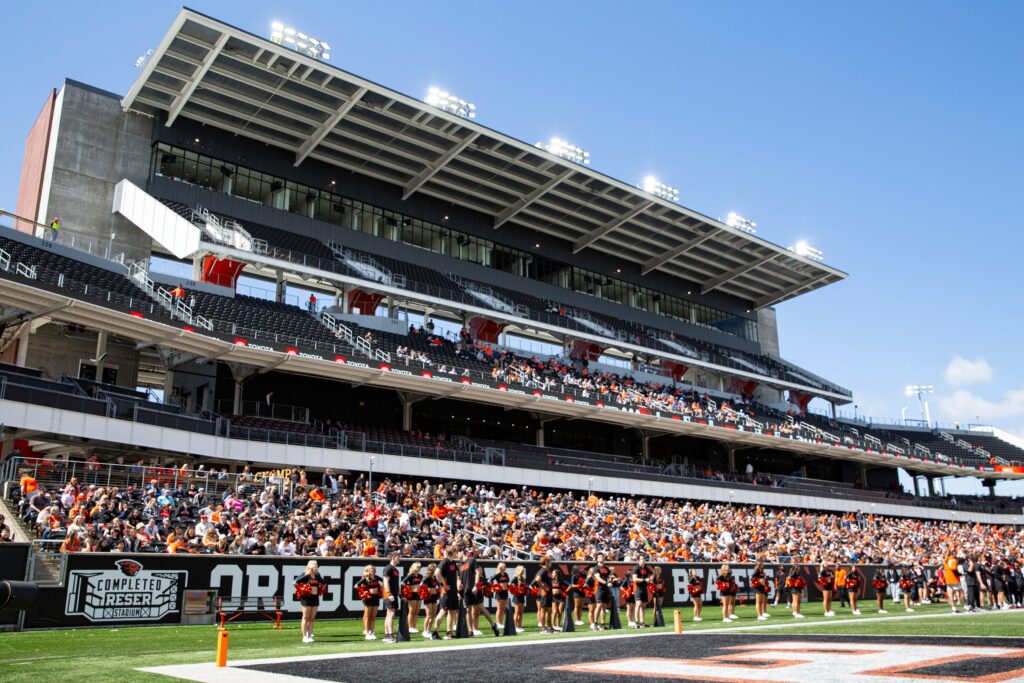
Collectives kind of sat on the outside of athletic departments themselves, versus now bringing the collective in-house under the management of Blueprint. For those kind of opportunities, because that’s what I also just want to understand now. What are the advantages of having Blueprint versus using a traditional collective for these opportunities?
BB: “Yeah, so the first part of that is, in one just note, like Blueprint isn’t technically in-house. Like they are a third party affiliate that we are partnering with to help provide these services. But the reason why you use a company like Blueprint is because their ability to – they’ve proven that they have the ability, I should say more correctly, to go out and get these true NIL deals.
And this is why we’ve seen a major sea change in collectives across the country since the summer, is because the way that most collectives used to operate was they were just a collection bin. It was donors would just write them a check and say, hey, I want good players to be able to cheer for, here’s my money, find a way to get it to the student athlete. There was not really a true NIL component to it.
They weren’t coming to have them do an activation at their business or do something else that would justify a true use of NIL. They were just donating to that the same way they would donate to the athletics department or anything else to say, hey, you’re the only entity that can pay these players, so I need you to find a way to pay them so that we can get good players. Well, with how the regulations have now changed, you can’t really do that anymore.
Or at least it’s highly regulated. Like you have to have any money that comes from a third-party entity like a collective. There has to be a valid business purpose.It has to be within a certain range of compensation. And all those things are being regulated deal by deal because you have to submit every single one. So with that, you need someone that understands partnerships and sponsorships and activations and multimedia rights and all the various components that could go in that because they’re truly having to go out and sell and sell legitimate business deals in order for it to get approved.
And so that’s why I was saying this new world with this new Dam Nation, this is all kind of new money for us. And it is additive to what would have been done before because a lot of what was being done before was in that donation-based model. And most of those funds are now being shifted directly to the institution for revenue sharing, but because those that give like the potential tax benefits and other things that they can come with giving the money directly to the institution.”
You were at the University of Arizona in the role of Senior Associate Athletics Director, Administration and Institutional Control from October 21st to May 2024. It seemed like you had a very, at least important role in helping bring Arizona’s NIL Collective in-house and building kind of that kind of market kind of up for the University of Arizona before you came here to Oregon State. Is that correct?
BB: “Yes, it was. And what I’ll do is provide some context on that because I do appreciate the question. So, the first thing, the Arizona Edge, which was the NIL program that we built out, that was an educational and student-athlete development model.
So, that was a platform that we built in combination with our School of Business, School of Law, Entrepreneurship School, some notable alums and other things to really teach and empower student-athletes how to take advantage of these new NIL opportunities. The second part to that was in the actual activations of NIL.”
So even with not having as much overlap as you said that you did with your time with Rob Sine at Arizona, there was still kind of that use of Blueprint’s kind of software and kind of how they structured everything with in-house NILs, there even for those other sports too.
BB: “Yeah. As I recall, there wasn’t very much activation in some of those other sports. But again, since Blueprint was taking football and in theory servicing the other sports with whatever level of activation that was, my focus, my role, my time was being invested in the men’s basketball program to run our own initiatives on that side.”
Additional Statements From Oregon State Executive Deputy AD Blaylock
“It needs to be said, because what’s being said is reckless and irresponsible. But it’s been brought to my attention that people are alleging that I have some family tie to Blueprint. There is no one associated with my family or extended family that has any level of involvement at all with Blueprint. And I can’t say that more categorically; wherever that came from is an absolute fabrication.
I have asked Blueprint for what their ownership structure is, just to see, is there maybe a mistaken last name? Is there something that could somehow be related to me? And there is no one within their group that anyone operating with any level of good faith could even come close to mistaking to be related to me.”
Final Statement
“I do just want to say that we understand the passion that our supporters have to make sure our coaches and our student athletes are being put in the best position for success. And we absolutely match that same passion. It is why we come to work every single day is to find the opportunities and in all the different ways that we can best position our student athletes and our sports programs as a whole for success. So, just very important for people to know. I understand the passion behind it, but I want everyone to know that we’re right there with them and wanting success for everybody.”
TALK ABOUT IT ON THE DAM BOARD
LISTEN TO OUR PODCASTS ON APPLE & SPOTIFY
FOLLOW THE STAFF ON TWITTER – @Beavers_Edge, @b_slaught, @DylanCCOn3, @ryan_harlan, & @BroganSlaughter
